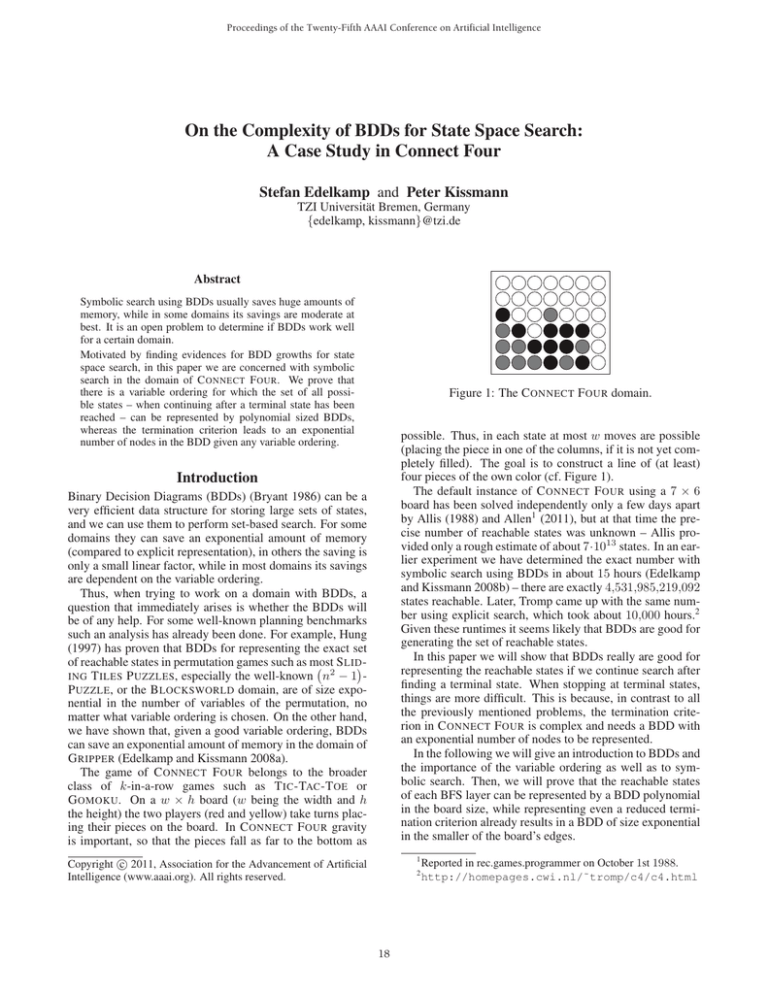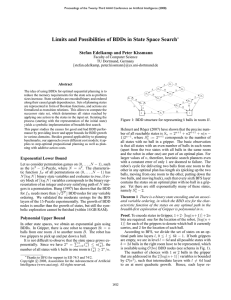
Proceedings of the Twenty-Fifth AAAI Conference on Artificial Intelligence
On the Complexity of BDDs for State Space Search:
A Case Study in Connect Four
Stefan Edelkamp and Peter Kissmann
TZI Universität Bremen, Germany
{edelkamp, kissmann}@tzi.de
Abstract
Symbolic search using BDDs usually saves huge amounts of
memory, while in some domains its savings are moderate at
best. It is an open problem to determine if BDDs work well
for a certain domain.
Motivated by finding evidences for BDD growths for state
space search, in this paper we are concerned with symbolic
search in the domain of C ONNECT F OUR. We prove that
there is a variable ordering for which the set of all possible states – when continuing after a terminal state has been
reached – can be represented by polynomial sized BDDs,
whereas the termination criterion leads to an exponential
number of nodes in the BDD given any variable ordering.
Figure 1: The C ONNECT F OUR domain.
possible. Thus, in each state at most w moves are possible
(placing the piece in one of the columns, if it is not yet completely filled). The goal is to construct a line of (at least)
four pieces of the own color (cf. Figure 1).
The default instance of C ONNECT F OUR using a 7 × 6
board has been solved independently only a few days apart
by Allis (1988) and Allen1 (2011), but at that time the precise number of reachable states was unknown – Allis provided only a rough estimate of about 7·1013 states. In an earlier experiment we have determined the exact number with
symbolic search using BDDs in about 15 hours (Edelkamp
and Kissmann 2008b) – there are exactly 4,531,985,219,092
states reachable. Later, Tromp came up with the same number using explicit search, which took about 10,000 hours.2
Given these runtimes it seems likely that BDDs are good for
generating the set of reachable states.
In this paper we will show that BDDs really are good for
representing the reachable states if we continue search after
finding a terminal state. When stopping at terminal states,
things are more difficult. This is because, in contrast to all
the previously mentioned problems, the termination criterion in C ONNECT F OUR is complex and needs a BDD with
an exponential number of nodes to be represented.
In the following we will give an introduction to BDDs and
the importance of the variable ordering as well as to symbolic search. Then, we will prove that the reachable states
of each BFS layer can be represented by a BDD polynomial
in the board size, while representing even a reduced termination criterion already results in a BDD of size exponential
in the smaller of the board’s edges.
Introduction
Binary Decision Diagrams (BDDs) (Bryant 1986) can be a
very efficient data structure for storing large sets of states,
and we can use them to perform set-based search. For some
domains they can save an exponential amount of memory
(compared to explicit representation), in others the saving is
only a small linear factor, while in most domains its savings
are dependent on the variable ordering.
Thus, when trying to work on a domain with BDDs, a
question that immediately arises is whether the BDDs will
be of any help. For some well-known planning benchmarks
such an analysis has already been done. For example, Hung
(1997) has proven that BDDs for representing the exact set
of reachable states in permutation games such as most
S LIDING T ILES P UZZLES, especially the well-known n2 − 1 P UZZLE, or the B LOCKSWORLD domain, are of size exponential in the number of variables of the permutation, no
matter what variable ordering is chosen. On the other hand,
we have shown that, given a good variable ordering, BDDs
can save an exponential amount of memory in the domain of
G RIPPER (Edelkamp and Kissmann 2008a).
The game of C ONNECT F OUR belongs to the broader
class of k-in-a-row games such as T IC -TAC -T OE or
G OMOKU. On a w × h board (w being the width and h
the height) the two players (red and yellow) take turns placing their pieces on the board. In C ONNECT F OUR gravity
is important, so that the pieces fall as far to the bottom as
1
c 2011, Association for the Advancement of Artificial
Copyright Intelligence (www.aaai.org). All rights reserved.
2
18
Reported in rec.games.programmer on October 1st 1988.
http://homepages.cwi.nl/˜tromp/c4/c4.html
Binary Decision Diagrams
x1
Binary Decision Diagrams (BDDs) (Bryant 1986) are a
memory-efficient data structure used to represent Boolean
functions as well as to perform set-based search. In short, a
BDD is a directed acyclic graph with one root and two terminal nodes, the 0- and the 1-sink. Each internal node corresponds to a binary variable and has two successors, one
(along the low edge) representing that the current variable
is false (⊥) and the other (along the high edge) representing
that it is true (). For any assignment of the variables derived from a path from the root to the 1-sink the represented
function will be evaluated to .
Bryant proposed to use a fixed variable ordering, for
which he also provided two reduction rules (eliminating
nodes with the same low and high successors and merging
two nodes representing the same variable that share the same
low successor as well as the same high successor). These
BDDs were called reduced ordered binary decision diagrams
(ROBDDs). Whenever we mention BDDs in this paper we
actually refer to ROBDDs.
x1
y1
x2
x2
x3
x3
y2
x3
y3
0
x2
x3
x3
y1
y1
y2
y2
y1
y1
y3
1
(a) Good variable ordering.
0
1
(b) Bad variable ordering.
Figure 2: Two possible BDDs representing DQF3 . Solid
lines represent high edges, dashed ones low edges.
Additionally, Sieling (2002) proved that there is no polynomial time algorithm that can calculate a variable ordering so that the resulting BDD contains at most c times
as many nodes as the one with optimal variable ordering
for any constant c > 1, so that we cannot expect to find
good variable orderings using reasonable resources. This
shows that using heuristics to calculate a variable ordering (Fujita, Fujisawa, and Kawato 1988; Malik et al. 1988;
Butler et al. 1991) is a plausible approach.
The Variable Ordering
For many Boolean formulas the corresponding BDD can be
of polynomial or even linear size, given a good variable
ordering π, although the number of satisfying assignments
(i. e., the number of states) might be exponential in n. One
such case is the Disjoint Quadratic Form (DQF).
Definition 1 (Disjoint Quadratic Form). The disjoint
quadratic form DQFn is defined as
Symbolic Search
State space search is an important topic in many areas of
artificial intelligence. No matter if we want to find a shortest
path from one location to another, some plan transforming a
given initial state to another state satisfying a goal condition,
or finding good moves for a game – in all these cases search
is of high importance.
In explicit search we need to come up with good data
structures to represent the states efficiently or algorithms
for fast transformation of states. In case of symbolic search
(McMillan 1993) with BDDs the data structure to use is already given. As to efficient algorithms, here we need to handle things in a different manner compared to explicit search.
While explicit search is concerned with expansion of single states and calculation of successors of a single state, in
symbolic search we handle sets of states. The assignments
satisfying a Boolean formula can be seen as sets of states, as
well. Similarly, we can represent any state we encounter in
a state space search as a Boolean formula with one satisfying assignment. To achieve this, we represent any state as a
conjunction of (binary) variables. Thus, a set of states can
be seen as the disjunction of such a conjunction of variables,
so that we can easily represent it by a BDD.
To perform symbolic search we need two sets of binary
variables. One set, S, stores the current states, while the
other set, S , stores the successor states. With these, we can
represent a transition relation, which connects the current
states with their successors.
For a given set of actions A, any action a ∈ A typically
consists of a precondition and a number of effects to specify the changes to a state satisfying the precondition and
DQFn (x1 , . . . , xn , y1 , . . . , yn ) := x1 y1 ∨x2 y2 ∨. . .∨xn yn .
Proposition 1 (Linear Size of a BDD for DQF). Given the
variable ordering π = (x1 , y1 , . . . , xn , yn ) the BDD representing the DQFn contains 2n + 2 nodes.
On the other hand, a bad variable ordering might result in
a BDD of size exponential in n. For the DQF we can find
such an ordering as well.
Proposition 2 (Exponential Size of a BDD for DQF).
Given the variable ordering π = (x1 , . . . , xn , y1 , . . . , yn )
the BDD representing the DQFn contains 2n+1 nodes.
Figure 2 illustrates both cases for the DQF3 .
Furthermore, there are some functions for which any
BDD contains Ω (2n ) nodes, e. g., integer multiplication, for
which Bryant (1986) proved that for any variable ordering
there is an output bit for which the BDD contains at least
2n/8 BDD nodes.
Finally, for some functions any variable ordering results
in a polynomial sized BDD. An example for this would be
any symmetric
function, for which a BDD contains at most
O n2 nodes.
Nevertheless, for many functions there are good variable
orderings and finding these might be crucial. Yet, finding
an ordering that minimizes the number of BDD nodes is
co-NP-complete (Bryant 1986). Furthermore, the decision
whether a variable ordering can be found so that the resulting BDD contains at most s nodes, with s being specified beforehand, is NP-complete (Bollig and Wegener 1996).
19
c1
Algorithm 1 Symbolic Breadth-First Search (SBFS)
Input: Search Problem P = V, A, I, T .
1: reach 0 ← I;
2: layer ← 0;
3: while reach layer = ⊥ do
4:
current ← reach layer ∧ ¬T ;
5:
reach layer +1 ← image (current);
6:
for 0 ≤ i ≤ layer do
7:
reach layer +1 ← reach layer +1 ∧ ¬reach i ;
8:
end for
9:
layer ← layer + 1;
10: end while
c2
c2
c3
c4
c3
c4
..
..
cn−k+1
...
cn−k+2
.
.
ck
ck+1 ck+1
ck+2
ck+2
ck+3
ck+4
...
..
..
.
.
cn
0
.
.
ck+3
cn−k+3
thus the successor state. For each a = (pre a , eff a ) ∈ A
we can generate one transition relation transa (S, S ) :=
pre a (S)∧eff a (S )∧frame a (S, S ) with frame a being the
frame for action a, which determines what parts of the current state do not change when applying a. These transition
relations can be combined to generate a single (monolithic)
transition relation trans by calculating the conjunction of all
the smaller transition relations:
trans a (S, S )
trans (S, S ) :=
..
c5
c6
...
..
c4
c5
...
c3
cn
1
0
Figure 3: Critical part of the BDD for representing k cells
being occupied by pieces of one color. Solid edges correspond to the cell being occupied by a piece of the color in
question, dashed ones to the other case.
a∈A
To calculate the successors of a set of states current, the
image operator is defined as
reaching terminal states. Afterwards, we will have a closer
look at the termination criterion and prove that even for a
simpler version of it we already need exponentially many
BDD nodes.
(∃S.trans (S, S ) ∧ current (S)) [S → S] .
Given a set of states current, specified in S, it calculates
all the successor states, specified in S . Afterwards, all
variables of S are replaced by those of S (denoted by
[S → S]), so that the successor states finally are represented
in S and we can continue the search.
The combination of conjunction and existential quantification used in the image operator, the so-called relational
product, is one of the bottlenecks in symbolic search, as its
calculation is NP-complete (McMillan 1993). Most BDD
packages contain implementations of the relational product
which are much more efficient than the manual execution of
conjunction followed by the existential quantification.
Given an implementation of the image operator, performing symbolic breadth-first search (BFS) is straight-forward
(cf. Algorithm 1). For any search problem P = V, A, I, T with V being a set of (Boolean) variables, A a set of actions,
I the initial state and T the set of terminal states, all we
need to do is to apply the image operator first to I and afterwards to the last generated successor state set. The search
ends when a fix-point is reached (line 3). For this we must
remove any terminal states before expanding a set of states
(line 4) and all duplicate states that might reside in a newly
generated BFS layer (lines 6 – 8).
Polynomial Upper Bound for Representing the
Reachable States
C ONNECT F OUR is a game where in each state l pieces are
placed on the n = wh positions of the game board, so that
its search space is exponential. Nevertheless, we can find a
variable ordering, so that the reachable states can be represented by a number of polynomial sized BDDs (one for each
BFS layer) if we continue after a terminal state has been
reached, i. e., if we omit the removal o terminal states (line
4 of Algorithm 1).
Theorem 3 (Polynomial Bound for BFS Layers without
Termination in C ONNECT F OUR). There is a binary state
encoding and a variable ordering for which the BDD size for
the characteristic function of any BFS layer in C ONNECT
F OUR is polynomial in n = wh, with w being the width and
h the height of the board, if we do not cut off the search after
reaching a terminal state.
Proof. We use 2n + 1 bits to encode a state in C ONNECT
F OUR, two for each cell (red / yellow / none) and one for
the active player. If we organize the encoding in a columnwise manner we need to calculate the conjunction of three
polynomial sized BDDs for each layer l.
Two BDDs are similar to the one in Figure 3. The first
represents the fact that we have k = l/2 red pieces on the
board, the second one that we have k = l/2 yellow pieces
on the board. As in this game the cells can also be empty we
need to replace each node by two, the first one distinguishing
BDD Sizes for C ONNECT F OUR
In this section we will analyze the behavior of BDDs in the
context of C ONNECT F OUR. First, we will prove that the
calculation of the set of reachable states can be done using polynomial sized BDDs if we continue the search after
20
co
i
ci
Exponential Lower Bound for the Termination
Criterion
cr
i
In the domains analyzed before, the termination criterion
was always trivial to model as a BDD. E. g., in the n2 − 1 P UZZLE and B LOCKSWORLD only one pattern is correct,
while in G RIPPER all balls must end up in room B.
In contrast to these, integrating the terminal states in the
set of reachable states (i. e., not continuing search from terminal states) in C ONNECT F OUR is a lot more difficult.
Here, the termination criterion is fulfilled if one player has
succeeded in placing four own pieces in a row (horizontally,
diagonally, or vertically), which results in a rather complex
Boolean formula.
In the following we will prove that even for a simplified
version of this termination criterion, i. e., one that is fulfilled
when four adjacent cells in a horizontal or vertical line are
occupied, any BDD is of exponential size for a C ONNECT
F OUR problem encoded in the way proposed in Theorem 3.
To prove this, we can reduce the termination criterion
even further.
Definition 2 (Reduced Termination Criterion). The reduced termination criterion Tr is the reduction of the
full termination criterion to the case where only two
horizontally or vertically
adjacent cells must be occupied, i. e., Tr =
1≤i≤w,1≤j≤h−1 (xi,j ∧ xi,j+1 ) ∨
(x
∧
x
i,j
i+1,j ) with xi,j specifying that
1≤i≤w−1,1≤j≤h
the cell at column i and row j is occupied.
We can represent the game board by a grid graph G =
(V, E), with V representing the wh cells of the board,
with edges only between horizontally or vertically adjacent
nodes. The reduced termination criterion corresponds to the
fact that two nodes connected by an edge are occupied.
Additionally, we make use of the disjoint quadratic form
DQF, which we introduced in Definition 1.
Lemma 4 (Exponential Bound for Tr ). For C ONNECT
F OUR in the cell-wise encoding from Theorem 3 with a
board size of w × h the size of the BDD for representing
Tr is exponential in min (w, h), independent of the chosen
variable ordering.
Figure 4: Replacement of a node representing that cell i is
occupied by a red piece by two nodes denoting that the cell
is occupied (coi ) and the occupying piece is red (cri ).
co
1
co
2
co
3
..
.
co
2
...
co
h−1
co
3
..
.
co
h−1
co
h
co
h+1
co
h+2
co
h+3
..
.
co
h+2
...
co
n−1
co
h+3
..
.
co
n−1
co
n
0
1
Figure 5: BDD for representing the fact that all pieces are
located at the bottom. Each node coi represents the decision
for cell i if it is occupied.
between the cases that a cell is empty or not and the second
one between the colors. If the cell is empty we insert an edge
to a node for the next cell; if it is not we distinguish between
the two colors (cf. Figure 4 for red pieces; for yellow pieces,
the low and high edges of the lower node are swapped). Due
to the replacement of each cell by two BDD nodes, each
BDD has a size of O (2kn) = O (ln).
The third BDD represents the gravity, i. e., the fact that all
pieces are located at the bottom of the columns. For this a
column-wise variable ordering is important. Starting at the
lowest cell of a column, if one is empty all the following
cells of this column are necessarily empty as well. If one is
not empty the others can still be empty or not. In this BDD it
is only relevant if a cell is occupied, so that the actual color
of a piece occupying a cell does not matter, which keeps the
BDD smaller. Thus, we need at most two BDD nodes for
each cell, resulting in a total of O (2n) = O (n) BDD nodes
(cf. Figure 5).
Calculating the conjunction of two BDDs of sizes s1 and
s2 results in a new BDD of size O (s1 s2 ), so that the conjunction of three polynomial BDDs is still polynomial.
2 3In
this case, the total BDD for each layer l is of size
O
5 l n .
As l is at most n, we arrive at a total size of O n .
Proof. To prove this we show that any variable ordering can
be split in two, so that Ω (min (w, h)) variables are in the
one part and connected to Ω (min (w, h)) variables in the
other part. Retaining at most one connection for each variable, we will show that Ω (min (w, h) /7) edges still connect
the two sets. These represent a DQF with a bad variable ordering, which will give us the exponential bound.
Given any ordering π on the variables we divide it into
two sets π1 and π2 with π1 being the first wh/2 variables
of π and π2 the remaining wh/2 variables. These sets
correspond to a partitioning of the grid graph G into two
sets.
The minimal number of crossing edges between these
partitions is in Ω (min (w, h)).
It is achieved when
each partition is connected and forms a rectangle of size
(max (w, h) /2)·min (w, h), so that the cut between the two
partitions crosses the grid in the middle but orthogonal to the
longer edge and thus crosses min (w, h) edges.
21
Number of BDD Nodes
25⋅106
20⋅10
6
15⋅10
6
10 Rows
9 Rows
8 Rows
7 Rows
10⋅106
5⋅106
0
0⋅10
Figure 6: Coloring of the game board in Lemma 5.
4
5
6
7
8
9
10 11
Number of Columns
12
13
14
15
(a) Fixed heights.
We might view the two partitions along with the connecting edges as a bipartite graph G = (V1 , V2 , E ), |E | =
min (w, h), for which we want to find a (not necessarily
maximal) matching. To find one, we choose one node from
V1 and a connecting edge along with the corresponding node
from V2 . The other edges starting at one of these nodes
are removed (there are at most six of them, as each node
can be connected to at most four neighbors, one of which
is chosen). This we repeat until we cannot remove any
more edges. As we choose one edge in each step and remove at most six, the final matching M contains at least
|E |/7 = min (w, h) /7 edges.
All variables that are not part of the matching are set to
⊥3 , while the others are retained. Thus, the corresponding
formula for Tr is the DQF over the two sets of variables representing the nodes that are part of the matching. All variables for the one set (V1 ∩ M ) appear before all variables
of the other set (V2 ∩ M ), so that we have a bad ordering
for these variables and the corresponding BDD is of exponential size. Thus, according to Proposition
BDDwill
2 the
min(w,h)
=
contain at least Ω 2min(w,h)/7 = Ω 21/7
min(w,h) nodes.
Ω 1.1
Number of BDD Nodes
108
107
106
10 Columns
9 Columns
8 Columns
7 Columns
6 Columns
5 Columns
105
104
3
10
4
5
6
7
8
9
10
Number of Rows
11
12
13
14
(b) Fixed widths (log-scale).
Figure 7: Number of BDD nodes for the termination criterion for one player. The variable ordering is according to the
columns.
In a similar fashion we can show that any BDD for the
fact that two (or four) diagonally adjacent cells are occupied
is exponential for any variable ordering. The combination
of all these results illustrates that any BDD representing the
termination criterion in C ONNECT F OUR is of exponential
size, no matter what variable ordering is chosen.
This result immediately implies that for square boards the
number of BDD nodes is exponential in the square root of
the number of cells,
√i. e.,
the BDD for representing Tr contains at least Ω 1.1 n nodes.
With this result we can show that the case of four adjacent
cells in a horizontal or vertical line being occupied results in
a BDD of exponential size as well.
Experimental Evaluation
For a column-wise variable ordering we have evaluated the
number of BDD nodes for representing the termination criterion of four pieces of one player being placed in a horizontal
or vertical line for several board sizes (cf. Figure 7). For a
fixed number of rows (cf. Figure 7a) the growth of the number of BDD nodes is linear in the number of columns, while
for a fixed number of columns (cf. Figure 7b) it is exponential in the number of rows. Though it first might seem like a
contradiction to our result, it actually shows that it holds for
the chosen variable ordering.
In this variable ordering the partitions induced by the split
of the variable ordering cut h edges. Thus, the resulting
BDD’s size is exponential in h. For the case of a fixed
height, h does not change, so that the size increases by a
constant amount of nodes. On the other hand, when fixing
the width, the size changes exponentially in the height, no
matter if it is smaller or larger than the width. This happens
because for the cases that the height is actually larger than
the width this variable ordering is not the best choice – in
those cases it should have been in a row-wise manner.
Lemma 5 (Exponential Bound for Four Pieces in a Horizontal or Vertical Line). Any BDD representing the part of
T that states that four cells in a horizontal or vertical line
must be occupied is exponential in min (w, h) for a board of
size w × h.
Proof. We can devise a two-coloring of the game board as
shown in Figure 6. Using this, any line of four pieces resides
on two white and two black cells. If we replace all variables
representing the black cells by we can reduce this part of
T to Tr . As this replacement does not increase the BDD
size, the BDD is exponential in min (w, h) as well.
3
Replacing a variable by a constant does not increase the number of BDD nodes.
22
Number of States or BDD Nodes
14
10
In the domains analyzed so far, the BDDs were either exponential for any variable ordering or polynomial for at least
one variable ordering. In C ONNECT F OUR we have identified a domain, for which BDDs can be polynomial, but only
if we do not construct the BDD for the termination criterion,
which itself is exponential.
The lower bound results of this paper are surprisingly general. We have proven that a BDD for representing the the
case of two adjacent cells being occupied – no matter by
what color – is of exponential size. This might come in
handy in the analysis of other domains. For example, in
C HESS part of a checkmate is that all cells adjacent to a king
are either occupied by its own figures or guarded by the opponent. Furthermore, the capture rule for pawns might be
formulated in a similar way, so that it is a possible candidate
for filling the final bucket in Table 1.
12
10
10
10
108
106
4
Ignored Terminals (States)
Stopped at Terminals (States)
Stopped at Terminals (Nodes)
Ignored Terminals (Nodes)
10
2
10
100
0
5
10
15
20
Layer
25
30
35
40
Figure 8: Comparison of the number of states and BDD
nodes for different layers with a 7 × 6 board when ignoring
terminal states and when stopping at terminal states. The
variable ordering is according to the columns.
Table 1: Classification of some benchmarks with respect to
the BDD sizes.
Polynomial
Termination
Criterion
Exponential
Termination
Criterion
Polynomial
Reachability
G RIPPER
Acknowledgments
Thanks to Deutsche Forschungsgesellschaft (DFG) for support in the project ED 74/11-1.
Exponential
Reachability
B LOCKSWORLD
S LIDING
P UZZLE
2T ILES
n − 1 -P UZZLE
References
Allen, J. D. 2011. The Complete Book of Connect 4: History, Strategy, Puzzles. Puzzlewright.
Allis, L. V. 1988. A knowledge-based approach of connectfour. Master’s thesis, Vrije Universiteit Amsterdam.
Bollig, B., and Wegener, I. 1996. Improving the variable
ordering of OBDDs is NP-complete. IEEE Transactions on
Computers 45(9):993–1002.
Bryant, R. E. 1986. Graph-based algorithms for Boolean
function manipulation. IEEE Transactions on Computers
35(8):677–691.
Butler, K. M.; Ross, D. E.; Kapur, R.; and Mercer, M. R.
1991. Heuristics to compute variable orderings for efficient
manipulation of ordered binary decision diagrams. In DAC,
417–420. ACM Press.
Edelkamp, S., and Kissmann, P. 2008a. Limits and possibilities of BDDs in state space search. In Fox, D., and Gomes,
C. P., eds., AAAI, 1452–1453. AAAI Press.
Edelkamp, S., and Kissmann, P. 2008b. Symbolic classification of general two-player games. In Dengel, A.; Berns, K.;
Breuel, T. M.; Bomarius, F.; and Roth-Berghofer, T., eds.,
KI, volume 5243 of LNCS, 185–192. Springer.
Fujita, M.; Fujisawa, H.; and Kawato, N. 1988. Evaluation
and improvements of Boolean comparison method based on
binary decision diagrams. In ICCAD, 2–5. IEEE.
Hung, W. 1997. Exploiting symmetry for formal verification. Master’s thesis, University of Texas at Austin.
Malik, S.; Wang, A. R.; Brayton, R. K.; and SangiovanniVincentelli, A. 1988. Logic verification using binary decision diagrams in a logic synthesis environment. In ICCAD,
6–9. IEEE.
McMillan, K. L. 1993. Symbolic Model Checking. Kluwer
Academic Publishers.
Sieling, D. 2002. The nonapproximability of OBDD minimization. Information and Computation 172(2):103–138.
C ONNECT F OUR
T IC -TAC -T OE
G OMOKU
Furthermore, we have evaluated the default instance of
7 × 6 along with the full termination criterion in two complete searches, one stopping at terminal states and one continuing after them (cf. Figure 8). Again we used a columnwise variable ordering. We can see that the number of states
in the first is smaller than in the second case, while the number of BDD nodes needed to represent these states is larger
in the first case. Thus, for this variable ordering we can
clearly see that the use of the termination criterion increases
the sizes of the BDDs.
Comparing the runtimes we arrive at a similar conclusion:
On our machine (Intel Core i7 920 with 2.67 GHz and 24 GB
RAM) the runtime decreased from 4:48 hours to 11 minutes
when ignoring the termination criterion.
Conclusion
In this paper we have determined bounds for the BDD sizes
for representing the reachable states (when ignoring terminal
states) as well as for representing the termination criterion
in C ONNECT F OUR. Though we have only analyzed one
state encoding (a cell-wise encoding), we believe that the
exponential lower bound also holds for any other encoding.
Another plausible encoding we see is a piece-wise encoding,
but for this the encoding of one state increases from 2n + 1
bits to n (log n + 1) bits. Furthermore, in our previous
analysis of S OKOBAN (Edelkamp and Kissmann 2008a) we
saw that at least for that domain the reachability analysis
becomes much more complex.
With the new results we can now classify several games
with respect to the complexity of BDDs (cf. Table 1).
23






